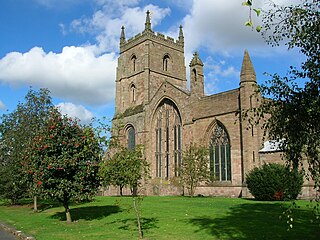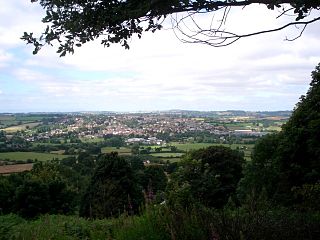
Hereford is a cathedral city, civil parish and the county town of Herefordshire, England. It lies on the River Wye, approximately 16 miles (26 km) east of the border with Wales, 24 miles (39 km) southwest of Worcester, and 23 miles (37 km) northwest of Gloucester. With a population of 60,800, it is by far the largest settlement in Herefordshire.

Leominster is a market and minster town in Herefordshire, England, at the confluence of the River Lugg and its tributary the River Kenwater 12 miles (19 km) north of Hereford and 7 miles south of Ludlow in Shropshire. With a population of 11,700, Leominster is the largest of the five towns in the county.

Bromyard is a town in the Bromyard and Winslow civil parish in the county of Herefordshire, England. It is situated in the valley of the River Frome. The 2011 census gives a population of approximately 4,500. It lies near to the county border with Worcestershire on the A44 between Leominster and Worcester. Bromyard has a number of traditional half-timbered buildings, including some of the pubs, and the parish church dates back to Norman times. For centuries there was a thriving livestock market. The town is twinned with Athis-de-l'Orne, Normandy.

Sir Robert Harley was an English statesman who served as Master of the Mint for Charles I and later supported the parliamentarians during the English Civil War.

Almeley is a village and civil parish in Herefordshire, England. The civil parish includes the hamlets of Almeley Wooton and Upcott. The 2011 Census recorded the parish's population as 601.

Bartestree is a village and civil parish in Herefordshire, England, 7 km (4.3 mi) east of Hereford on the A438 road. The population of the civil parish at the 2011 census was 330.
Richard de Capella or Richard of the Chapel was a medieval Bishop of Hereford.

Sir Thomas Coningsby was an English soldier and Member of Parliament, notable for his diary of military action in France in 1591.

John Scarlett Davis, or Davies, was an English landscape, portrait and architectural painter, and lithographer.
The Woolhope Naturalists' Field Club is a society devoted to the natural history, geology, archaeology, and history of Herefordshire, England. Founded in 1851, it has had many notable members and played an important early role in the history of mycology in Britain.

The Old House is a distinctive black and white half-timbered house in High Town, Hereford, England, built in 1621. It was restored in the 19th century and became a museum of Jacobean life in 1929.

Blackfriars Friary was a medieval Dominican friary dating back to the thirteenth century. The remains of the friary, located in Hereford, England, consist of monastery ruins, a cemetery, and a stone preaching cross. The ruins are surrounded by a rose garden established by the local community in 1964.
John Prophet (1356–1416) was an English medieval Secretary to King Henry IV, Keeper of the Privy Seal and, Dean of Hereford and York. A distinguished and capable administrator he remained loyal to all kings through a mix of shrewdness, and cunning. Although guilty of simony and pluralism, Prophet was no lollard, but successfully made the transition from Richard II's extravagant court at Westminster to an indispensable servant of the Lancastrians.

Grange Court is a former market hall in Leominster, Herefordshire, England. It was built in 1633 by John Abel, and moved to its present location in 1859. It was then used as a private house until the 1930s, and is now once again a civic building.

Leominster Museum, formerly known as Leominster Folk Museum, is an independent, volunteer-run, museum in Leominster, Herefordshire, England.

Hereford County Hospital is an acute general hospital on Stonebow Road in Hereford. It is managed by Wye Valley NHS Trust.

The Shirehall is a building on St Peter's Square, Hereford, England. It has been designated by English Heritage as a grade II* listed building.
Hereford Dispensary was founded in 1835. In 1837 the Dispensary was moved to a house in Bye Street Hereford. It was part of the Dispensary Movement. It was a public dispensary, which gave advice and medicine free-of-charge, or for a small charge. In its first year it saw 178 patients. By 1839 it had seen 600 patients.















